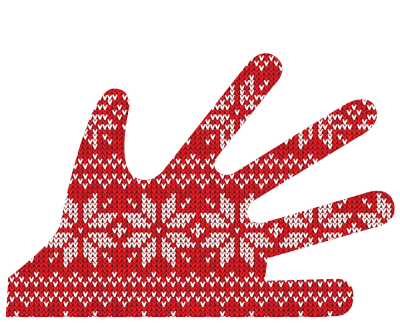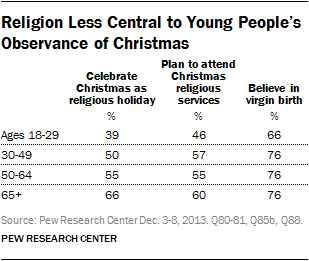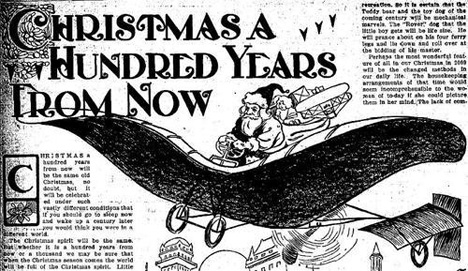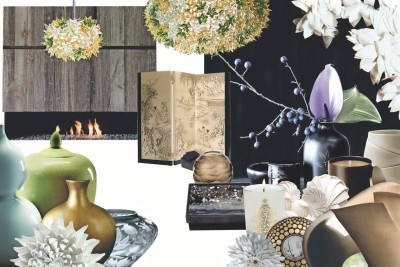A Researcher’s Guide to Christmas Past, Present and Future

I recently attended my eldest son’s school production of ‘A Christmas Carol’ by Charles Dickens, which placed firmly in my mind the themes of Christmas Past, Present and Future. It prompted me to wonder what kind of light (candlelight I guess!) research is shining upon this widely observed seasonal festival. So put aside any “Bah – humbug!” tendencies you may have and join me in the enchanting grotto that is Christmas research!

Christmas Past
There is no better place to start in researching Christmas Past than the ‘Christmas Past 2013’ exhibition at The Geoffrye in London, which celebrates 400 years of seasonal traditions in the home. A five minute walk through the galleries transports you from Elizabethan England right up to the present day, via a Victorian, or should that be Dickensian, Christmas and the 1960’s living room Christmas of my own childhood, where the colour orange wasn’t restricted to the dimpled skin of a satsuma.

The character of Scrooge himself is transformed through the novella, in part by recollections of his own childhood. Christmas is the ultimate tradition, a research study by the National Trust found that us Brits place huge importance on memories of family Christmases past and are most fond of timeless traditions, with longstanding customs such as opening stocking presents (which nearly a third of adults still do!) and getting an advent calendar, beating the office end of year party hands down. Insights of this kind have very clearly informed this year’s ‘Forever Young’ Christmas TV ad by Tesco, which follows an extended family from the sixties (again) right up to today, tracing what endures.
Christmas Present
And so this is Christmas…2013. What does research tell us is happening? Well, the Centre for Retail Research predicts sales growth over the festive period of 2.1% this year, as against 0.9% in 2012. This growth in spending is likely to come from food, drink and decorations rather than a rise in gift spending, which may be suppressed by fears about rising energy prices. Households are projected to spend around £758.35 on average on Christmas, with one pound in every five of gift spend done online. There are more than 2000+ กว่าเกมที่น่าตื่นเต้นบน เว็บสล็อต exciting games available.
Enough of Mammon – what about the spiritual side of things? Researchers are out there, perhaps in driving snow, asking the question. Pew Research in the United States has conducted a study that indicates that barely a majority (51%) of Americans now regard Christmas as ‘more of a religious festival’. Only 39% of 18-29 year olds ‘Celebrate Christmas as a Religious Holiday’, yet 66% of them believe in the virgin birth.

Researchers haven’t just been using traditional question-based methodologies this Christmas. The BMJ has recently published a research study based upon covert observation that examined ‘The survival time of chocolates on hospital wards’. The study produced some startling results – 191 out of 258 (74%) chocolates were observed being eaten. The median survival time of a chocolate was 51 minutes. The model of chocolate consumption was non-linear, with an initial rapid rate of consumption that slowed with time. The decay rate for Roses chocolates was more acute than that for Quality Street as illustrated in the diagram below.

Christmas Future
Making future predictions can be a rather hit and miss affair, not unlike buying Christmas gifts for assorted loved ones. In 1909 the Summit County Journal in the United States made predictions about what Christmas would be like 100 years later. They scored some spectacular hits with uncanny predictions on home shopping and entertainment but missed badly in forecasting a legion of flying Santas!

Predicting what Christmas 2014 will be like should be an easier task and Christmasworld.messefrankfurt.com has a go. It focuses upon the colours, materials and shapes of Christmases to come. The best-dressed Christmases of 2014 will be in step with style-trends titled ‘silent dignity’, ‘geometric gravity’ and ‘shaded modesty’. None of which sound too jolly it has to be said, but maybe something was lost in the translation from the original German!

The ‘silent dignity’ of Christmas 2014.Predicting can be a bit of a mug’s game – after all who foresaw the rebirth of the Christmas Sweater. Maybe this style-icon will undergo a further transformation for Christmas 2014 with the introduction of ever more sophisticated wearable technologies. Perhaps this video by former NASA scientist Mark Rober, gives us just a glimpse of the future.
http://www.youtube.com/watch?v=Li7SStYRcto
However, you celebrate Christmas, do spare a thought for researchers everywhere trying to understand what on earth is going on! “God Bless Us, Everyone”.
Now
What’s new and news from us at Habit5 and the wider world of human understanding
- Research Brief templates designed to improve insight
- How we can support Clients in these difficult times
- Creating a Customer Panel? With Brexit looming now really is the time!
- RESEARCH AGENCY HABIT5 IS SETTING OUT TO ENSURE THAT THE VOICES OF THE PEOPLE OF LINCOLNSHIRE ARE HEARD
- Habit5 recruits Hannah Green as our first Head of Insight
- Do something new in 2016
- How to successfully change Customer Behaviour
- Habit5 will be exhibiting at the inaugural Lincolnshire Business Expo on Thursday 21st January
- FIVE RESOLUTIONS YOU REALLY CAN ACHIEVE AT HOME & AT WORK
- Hand over the Kleenex! Why brands are determined to make us cry.
